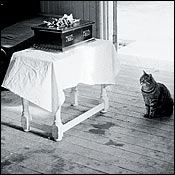
Manny Mondaca pulls a small black cat out of its cage in a room where the walls are painted a comforting pastel blue. He lays the animal gently on a steel table covered by a soft quilt and scratches it behind its left ear. He strokes it a few times. He takes care to treat the cat especially kindly, because he is about to kill it. With Smooth Jazz 101.9 playing in the background, Mondaca’s colleague, Leticia Arroyo, picks up a hypodermic needle filled with a blue poison called “Fatal Plus.” It lulls an animal to sleep before it dies. The cat registers the needle’s soft entry into its belly with just a twitch of an ear.
Welcome to the new era of reduced-cruelty euthanasia. Mondaca is a technician with Animal Care & Control of New York City, the nonprofit that runs the city’s animal shelters, which take in more than 50,000 stray dogs and cats a year. Last year, it had to put down 23,745 of them. That’s the smallest number in AC&C’s history, thanks to adoption outreach and increased funding for spaying and neutering. The goal of the center’s director, Edward Boks, is to be “no-kill” by 2009. In the meantime, he’s instituted steps to make an animal’s passing a little easier. Shelters in some parts of the country still kill animals en masse with carbon monoxide, says Boks. And while many shelters use injections, he adds, most don’t bother with soft music, comfortable tables, and soothing wall colors. Some even allow doomed animals to witness another’s death. “Animals can sense fear in other animals,” Boks says.
These changes might actually be more about reducing cruelty for the humans performing the procedures. Some technicians at the shelter have trouble coping with their roles—one repeatedly became hysterical before euthanasia sessions. “Pastels might make the people feel better,” says Colorado State University animal-behavior expert Temple Grandin. Though she points out that relaxing the staffers could make the animal’s last moments more relaxed as well.
“Until we achieve no-kill,” says Boks, “we should create comfort in their last moments. This may be the first loving touch they’ve ever had—even if it’s their last.”